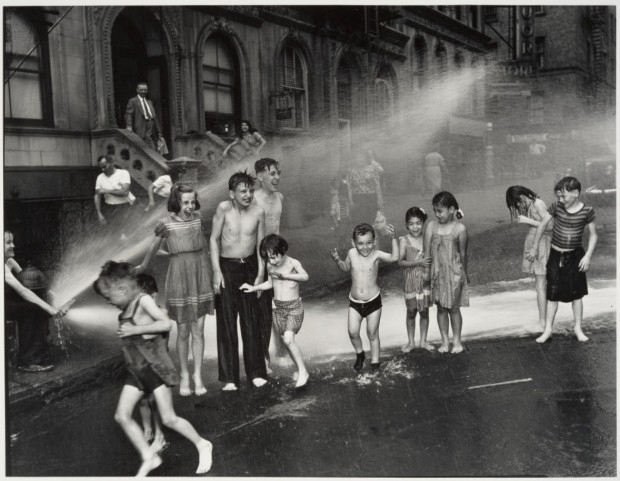An iconographic and text archive related to communication, technology and art.
☛ The Metropolitan Museum of Art: “Children on Fire Escape” by Weegee (Arthur Fellig), gelatin silver print, 32.2 x 40.3 cm. (12 11/16 x 15 7/8 in.), 1938. Accession Number: 1983.1130.35 © Weegee / International Center of Photography.
In 1998, American playwright Arthur Miller wrote an essay for The New Yorker titled “Before Air-Conditioning” where he shares his memories of hot summers spend in New York. Among other things ―the whole essay is quite colorful and worth reading― he explains how New Yorkers cope with the heat at night:
People on West 110th Street, where I lived, were a little too bourgeois to sit out on their fire escapes, but around the corner on 111th and farther uptown mattresses were put out as night fell, and whole families lay on those iron balconies in their underwear.
Even through the nights, the pall of heat never broke. With a couple of other kids, I would go across 110th to the Park and walk among the hundreds of people, singles and families, who slept on the grass, next to their big alarm clocks, which set up a mild cacophony of the seconds passing, one clock’s ticks syncopating with another’s. Babies cried in the darkness, men’s deep voices murmured, and a woman let out an occasional high laugh beside the lake. I can recall only white people spread out on the grass; Harlem began above 116th Street then. (The New Yorker: “Before Air-Conditioning” by Arthur Miller, June 22, 1998, p. 144)
Weegee’s photo also appears in his book Naked City (New York: Essential Books, 1945, p. 23). It is captioned with those words:
But the other fire escape is somewhat overcrowded… it’s not so bad sleeping that way… except when it starts to rain… then back to the stuffy tenement rooms.
Weegee took more than one photo of the same scene and those pictures were reproduced numerous times in various newspapers and magazines. For an exhaustive account of those takes and prints, one should take a look at the blog Weegeeweegeeweegee maintained by Chris George. See specifically the post “Tenement Penthouse” (published on August 12, 2009). In some instances, the partially exposed breast of the girl holding a cat seems to have been erased.
The International Center is currently holding an exhibition about Weegee’s career: Weegee: Murder Is My Business (May 18 through September 2, 2012):
For an intense decade between 1935 and 1946, Weegee (1899–1968) was one of the most relentlessly inventive figures in American photography. His graphically dramatic and often lurid photographs of New York crimes and news events set the standard for what has become known as tabloid journalism. Freelancing for a variety of New York newspapers and photo agencies, and later working as a stringer for the short-lived liberal daily PM (1940–48), Weegee established a way of combining photographs and texts that was distinctly different from that promoted by other picture magazines, such as LIFE. Utilizing other distribution venues, Weegee also wrote extensively (including his autobiographical Naked City, published in 1945) and organized his own exhibitions at the Photo League.
For more information about Weegee and this exhibition, see NPR: “Film Noir: Weegee Was His Name; Murder Was His Game” by Margot Adler, January 29, 2012.
Below is another photo by Weegee showing kids playing around a leaking fire hydrant to cool themselves off. Also retrieved from The MET.

- By Philippe Theophanidis
- on
- ― Published in Art, Communication, Literature, Photography
- Tagged: Arthur Miller, children, heat, kids, New York, outside, summer, Weegee

